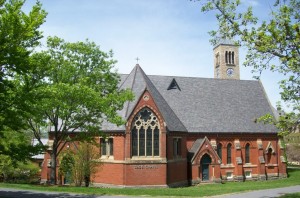Sage Chapel features two stained-glass windows that each honor a Cornellian who died in WWI. They were a gift of H. Hamilton Allport ’12 in memory of his Sigma Phi fraternity brothers, Chandler Montgomery and Wilhelmus Mynderse Rice. Allport served as a fellow officer with Montgomery and Rice in the American Expeditionary Forces in France in 1917-1918. The windows, on the Northeast corner of Sage Hall just behind the organ, were installed in early 1956 and dedicated on April 21st of that year. [44][64]
The windows are on the Northeast corner of Sage Hall, just behind the organ. They are the two windows to the left in the below image.
Beneath each window is a small plaque. They read:
“In memory of Chandler Montgomery, Cornell 1912 ME, 323d F. A. American Expeditionary Forces. Wounded in action, Meuse-Argonne, France, October 1918. Died of wounds September 16, 1919.”
“In memory of Wilhelmus Mynderse Rice, Cornell 1912 Law. 28th Div. April 1, 1956 American Expeditionary Forces. Killed in action, Le Chene-Tondu, France, October 2, 1918.”
The windows from the outside (to the right in this view).
Chandler Montgomery ‘12 was born August 1st 1890 in Flushing N.Y. He entered the Sibley College in 1908 and graduated Cornell with a degree in mechanical engineering in 1912. He was a member of Sigma Phi and the Cornell Club of Cleveland. He enlisted in the Army in 1914 at the beginning of the War and went to France in June 1918 as captain of the 323rd Field Artillery. He died at home in Cleveland Ohio on September 16, 1919 of wounds he had received in combat. [45][63]
Captain Wilhelmus Mynderse Rice graduated from Cornell Law School in 1912. He was a member of Sigma Phi. He enlisted in Company M of the New York National Guard at Auburn, N.Y., in 1916, receiving his promotion to the rank of Corporal while at Pharr, Tex. [63]
Upon his discharge from the National Guard he entered the First O.T.C. at Madison Barracks, N.Y. in May 1917, was commissioned as a Second Lieutenant and after a short period at Camp Dix, N.J., was assigned to the 111th Infantry, 28th Division, at Camp Hancock, GA. For a part of the three months at Hancock he performed the duties of Judge advocate. He went overseas in February, 1918, on special duty, acting for a time as billeting officer. In June, he rejoined his division, serving through the actions at Chateau-Thierry (teri), the Vesle (veslay), and the Aisne (ein), and was commissioned a First Lieutenant in August, 1918.
Later during the Meuse-Argonne (muse-argone) Offensive, he was assigned to staff duty at the headquarters of the division, and on October 2 was on a special mission for the divisional Chief of Staff, obtaining information as to the progress of the engagement on Le Chene-Tondu (chain tondu) Ridge. While on duty in the front line, Lieutenant Rice was severely wounded in the arm and chest by shrapnel, and died the same day in American Red Cross Hospital 114.
The order announcing his promotion to a Captaincy was issued after his death, on October 29, 1918. Captain Rice was also posthumously awarded the Silver Star for gallantry in action on 30 Dec 1922. The award reads: First Lieutenant Rice distinguished himself by gallantry in action while serving with Company M, 111th Infantry Regiment, 28th Division, A.E.F., in action 30 September to 2 October 1918, near Le Chêne Tondu, France, in making personal reconnaissance under artillery and machine gun fire in locating enemy front lines. On the third day of this hazardous duty, he was killed by a hostile shell. [4][20][27]
Captain Rice’s fellow classmates of the class of 1912 were the first to endow memorial rooms in the War Memorial, remembering not only Captain Rice but other members of their class lost to the war including George L. Walter, Jr., Eugene Arthur Conklin, Lindley Haines DeGarmo, Robbert Tussey Isett, Duncan Ross MacDonnell, Stanley Nathanial Miller, Kenneth H. Nash, John Edwin Ray, Jr., Gabriel Taccoen and George Leonard Walter, Jr. [65]
Sage Chapel was built in 1874 and is the non-denominational chapel on Cornell’s Ithaca campus. It serves as the final resting place of many Cornell luminaries, including the university’s founders, Ezra Cornell and Andrew Dickson White, and their wives. [9]


